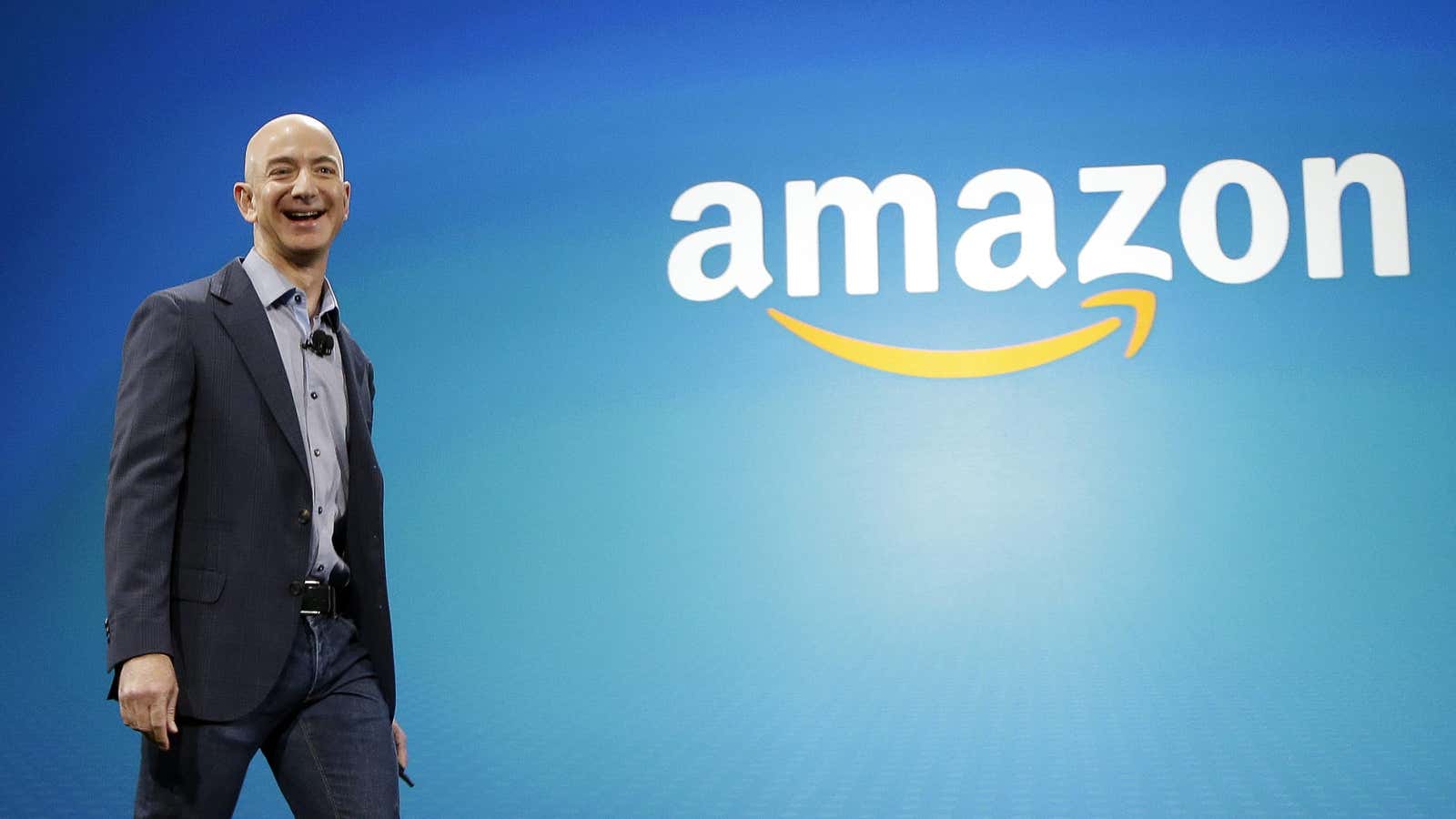In just the last one month, Amazon has made several seemingly small moves in India that could go a long way in helping the Seattle-headquartered company sink its teeth deeper into the country.
From investing in offline retail to introducing its global flagship products, and even strengthening its distribution network, the Jeff Bezos-led company is using a multi-pronged approach instead of focusing only on discounting to attract customers.
“Amazon has demonstrated time and again that it is here for the long haul and to fulfill the growing aspirations (of Indian consumers),” Sandeep Murthy, co-founder of Mumbai-based Lightbox VC, told Quartz. All these smaller milestones are a build up to “be in a position to ride the next wave of e-commerce customers,” he added.
Launched in 2012, Amazon India is already the second-largest e-commerce company in the country, and fiercely competes with home-grown Flipkart, which started out in 2008.
Here are some of the announcements made by Amazon in the last month that signal the company’s bullishness for India:
Strategic investments: On Sept. 23, Amazon said it will pick up a 5% stake in Shoppers Stop, one of India’s leading departmental store chains, for Rs179.25 crore ($27 million). The move comes at a time when several online retailers in India are trying to take the omnichannel route—having both an online and offline presence. As part of this deal, Amazon will open its “experience centers” across Shoppers Stop outlets. Additionally, Amazon India will also list the more than 400 Shoppers Stop brands on its website.
Making more money: Earlier this month, Amazon India said it will increase the subscription fee for its Prime membership to Rs999 a year from Rs499 now. Amazon Prime was launched in India in 2016 and offers one- and two-day delivery and exclusive discounts for members, as well as access to hundreds of movies and TV shows through Prime Video. The price is being increased because of the “tremendous response received from customers that has led to Prime sign-ups more than doubling since our launch,” an Amazon India spokesperson told Quartz, without disclosing the total number of Prime customers. As per estimates, Amazon India has as many as 6 million Prime members.
“They are creating a sense of urgency in getting people to sign up,” Murthy said. “It’s a clever marketing tactic at exactly the right time, when content consumption is growing by leaps.” Amazon’s first Indian original programme, the sports-drama Inside Edge, became the most watched title on Prime Video within the first week of its launch, and it bagged the title of highest completion rate of any show on the platform.
A payments play: Earlier this month, Amazon channeled a Rs2,000 crore investment into its digital wallet, Amazon Pay, to close the gap between sellers and potential consumers. In a Slicepay-meets-Paymate model, the product allows consumers to buy goods immediately but pay for them in installments over time.
Building up Amazon Pay is in line “with a long-term perspective to make e-commerce a habit for Indian customers and to invest in the necessary technology and infrastructure to grow the entire ecosystem,” the company told Quartz.
A product play: Amazon has launched Echo, a hands-free speaker that can be controlled by voice, in India. Google Assistant-based Home and Apple’s HomePod, which compete with Echo, are still far from an India entry. Amazon’s speakers are currently selling on an invite-only basis, and will be shipped by the end of October. Along with Echo, Amazon’s cloud-based voice assistant Alexa will also debut in India. Alexa can comprehend English spoken with an Indian accent and understand proper nouns—names of places, people, songs, movies—in local languages, an Amazon spokesperson told CNBC.
“Voice is the new battlefront and India is a key battle-ground for Amazon. (It can help to) further decimate local Indian competitors like Flipkart and tap into a rapidly expanding market,” Anindya Ghose, director of New York University’s Center for Business Analytics, told Quartz.
Separately, earlier this week, Amazon filed a patent application in India to deploy drones that can deliver packages by tracking certain markers.
Content USP: On Oct. 04, Amazon said it is planning to launch Prime Music in India, complete with Bollywood and regional songs. Amazon has been investing heavily to create local video content for its Indian audience, and now has a repertoire of original shows and comedy content, as well as movies, thanks to partnerships with leading production houses.
Game, set, match
Even as Amazon India seems to have armed itself for a battle with local competitors, there could be several pitfalls ahead.
For starters, India is a highly price-sensitive market where consumers can easily be lured by discounting. So selling at lower prices than competition will continue to remain a key decider to who wins the online retail battle in India.
Also, the country’s expensive and inefficient internet connectivity is posing a challenge for e-commerce companies in India, and Amazon is likely to struggle with it, too, especially as it banks on products like Amazon Music and Amazon Pay.
